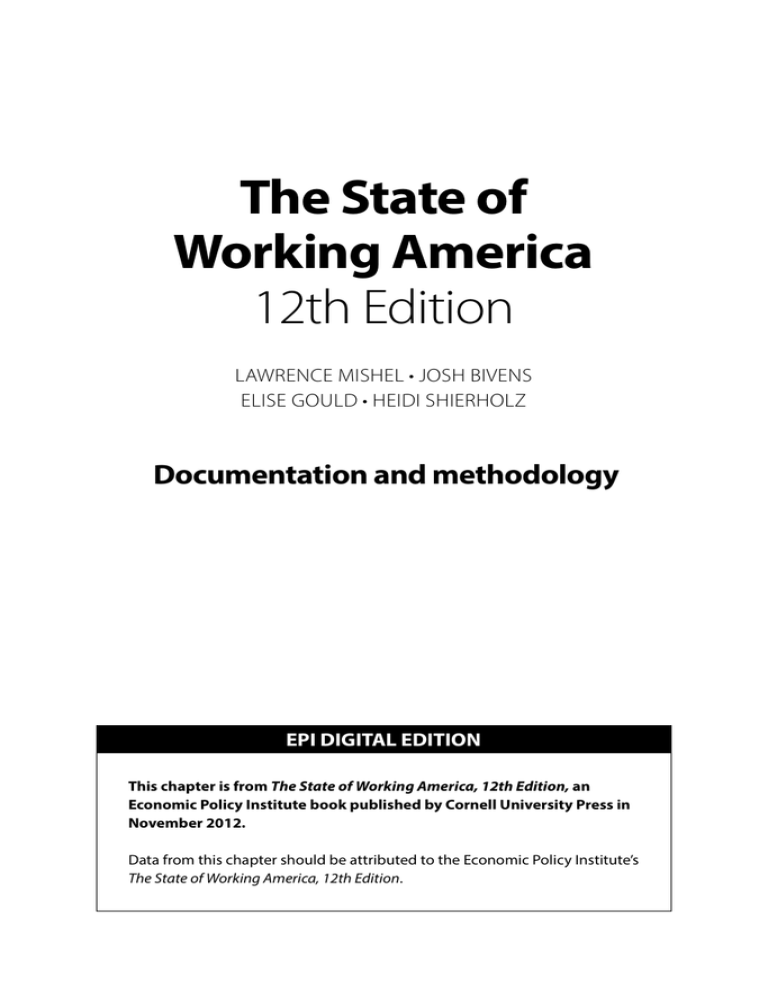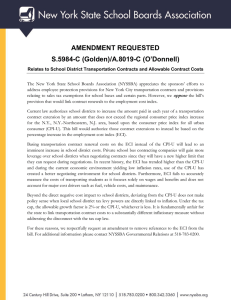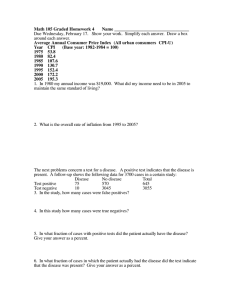Documentation - State of Working America
advertisement

The State of Working America 12th Edition LAWRENCE MISHEL • JOSH BIVENS ELISE GOULD • HEIDI SHIERHOLZ Documentation and methodology EPI DIGITAL EDITION This chapter is from The State of Working America, 12th Edition, an Economic Policy Institute book published by Cornell University Press in November 2012. Data from this chapter should be attributed to the Economic Policy Institute’s The State of Working America, 12th Edition. Documentation and methodology Documentation This book’s comprehensive portrait of changes over time in incomes, taxes, wages, employment, wealth, poverty, and other indicators of economic performance and well-being relies almost exclusively on data in the tables and figures. Each table and figure has an abbreviated source notation that corresponds with a full citation in the bibliography at the end of the book. More detailed documentation (as well as information on methodology) is contained in the table and figure notes found at the end of each chapter. This system of documentation allows us to omit distracting footnotes and long citations within the text and tables. In instances where we directly reproduce other people’s work, table and figure source lines provide an “author/year” reference to the bibliography. Where we present our own computations based on other people’s work, the source line reads “Authors’ analysis of (source).” In these instances we have made computations that do not appear in the original work and are thus responsible for our analyses and interpretations. We also use this source notation when presenting descriptive trends from government income, employment, or other data, since we have made judgments about the appropriate time periods or other matters for the analysis that the source agencies have not made. When we present our own analysis of survey data we list the name of the survey and cite as a source “Authors’ analysis of [name of Survey].” The table or figure notes provide information on the data analysis. 1 2 T H E S TAT E O F W O R K I N G AM E R I C A Time periods Economic indicators fluctuate considerably with short-term swings in the business cycle. For example, incomes tend to fall in recessions and rise during expansions. Therefore, economists usually compare business cycle peaks with other peaks and compare troughs with other troughs so as not to mix apples and oranges. In this book, we examine changes between business cycle peaks. The initial year for some tables is 1947, with intermediate years of 1967, 1973, 1979, 1989, 2000, and 2007, all of which were business cycle peaks (at least in terms of having low unemployment). We also present data for the latest full year for which data are available (2010 or 2011 when available). Whenever figures show recessionary periods we base these on the National Bureau of Economic Research dating of cycles (NBER 2010). In some tables, we also separately present trends for the 1995–2000 period (referred to as the late 1990s) in order to highlight the differences between those years and those of the early 1990s (or, more precisely, 1989–1995) and the business cycle of 2000–2007. This departs from the convention of presenting only business cycle comparisons (e.g., comparing 1979–1989 with 1989–2000 trends) or comparisons of recoveries. We depart from the convention because there was a marked shift in a wide variety of trends after 1995, and it is important to understand and explain these trends. We frequently refer to the 1979–2007 period because it represents the long period of growing inequality that predated the recession that began at the end of 2007. Growth rates and rounding Since business cycles differ in length, to facilitate comparisons we often present the average annual growth rates in each period rather than the total growth. In some circumstances, as noted in the particular tables, we have used log annual growth rates. This is done to permit decompositions. In presenting the data, we round the numbers, usually to one decimal place, but we use unrounded data to compute growth rates, percentage shares, and so on. Therefore, it is not always possible to exactly replicate our calculations by using the data in the table. In some circumstances, this leads to an appearance of errors in the tables. For instance, we frequently present shares of the population (or families) at different points in time and compute changes in these shares. Because our computations are based on the “unrounded” data, the change in shares presented in a table may not exactly match the difference in the actual shares. Such rounding discrepancies are always small, however, and never change the conclusions of the analysis. D O C U M E N TAT I O N A N D M E T H O D O LO G Y 3 Adjusting for inflation In most popular discussions, the Consumer Price Index for All Urban Consumers (CPI-U), often called the consumer price index, is used to adjust dollar values for inflation. However, some analysts hold that the CPI-U overstated inflation in the late 1970s and early 1980s by measuring housing costs inappropriately. The methodology for the CPI-U from 1983 onward was revised to address these objections. Other changes were introduced into the CPI-U in the mid-1990s but not incorporated into the historical series. Not all agree that these revisions are appropriate. We choose not to use the CPI-U to avoid any impression that this book’s analyses overstate the decline in wages and understate the growth in family incomes over the last few decades. Instead of the CPI-U, we adjust dollar values for inflation using the Consumer Price Index Research Series Using Current Methods (CPI-U-RS). This index uses the post-1983 methodology for housing inflation over the entire 1967–2007 period and incorporates the 1990s changes into the historical series (though not before 1978, as doing so would make economic performance in the years after 1978 falsely look better than the earlier years). The CPI-U-RS is now used by the Census Bureau in its presentations of real income data. Because it is not available for years before 1978, we extrapolate the CPI-U-RS back to earlier years based on inflation as measured by the CPI-U. In our analysis of poverty in Chapter 7, however, we generally use the CPI-U rather than the CPI-U-RS, since the chapter draws heavily from Census Bureau publications that use the CPI-U. Moreover, the net effect of all of the criticisms of the measurement of poverty is that current methods understate poverty. Switching to the CPI-U-RS without incorporating other revisions (i.e., revising the actual poverty standard) would lead to an even greater understatement and would be a very selective intervention to improve the poverty measurement. (A fuller discussion of these issues appears in Chapter 7.) The Current Population Survey Many tables and figures in the book are based on original analyses of survey data generated by the monthly Current Population Survey (CPS), which is best known for producing the monthly unemployment rate and for the annual data on poverty and incomes. There are three separate CPS sources of data employed in our analyses: the Annual Social and Economic Supplement (the ASEC, commonly referred to as the March Supplement), the full monthly public data series, and the Outgoing Rotation Group. We examine trends in annual household or family income and poverty, as well as employer-provided benefits (health and pension) and annual wages, using the March Supplement. The formal name for these data and the way the data are referred to in source notes is the “Current Population Survey Annual Social and Economic Supplement microdata” or “Current Popula- 4 T H E S TAT E O F W O R K I N G AM E R I C A tion Survey Annual Social and Economic Supplement Historical Income Tables.” Details of our use of the March microdata are presented in Appendix A. We employ the full samples of the monthly CPS in analyses of employment/unemployment trends, and this is referred to in source notes as “basic monthly Current Population Survey microdata.” The CPS Outgoing Rotation Group (CPS-ORG) provides information on the wages of workers for one-fourth of each month’s sample, and we use these data for analyses of wage trends. These data are referred to in source notes as “Current Population Survey Outgoing Rotation Group microdata.” Details of our use of these wage data are provided in Appendix B. Household heads and families We often categorize families by the age or the racial/ethnic group of the “household head,” that is, the person in whose name the home is owned or rented. If the home is owned jointly by a married couple, either spouse may be designated the household head. Every family has a single household head. A “household head” may sometimes be referred to as the “householder.” Black, Hispanic, and white designations Unless otherwise noted, races/ethnicities are presented in the following mutually exclusive categories: White refers to non-Hispanic whites, black refers to nonHispanic blacks, and Hispanic refers to Hispanics of any race. However, we sometimes use data from published sources that employ the U.S. Census Bureau’s convention of including Hispanics in racial counts (e.g., with blacks and whites) as well as in a separate category. For instance, in Table 2.5 a white person of Hispanic origin is included both in counts of whites and in counts of Hispanics. In these cases, we alert readers to the exception.


